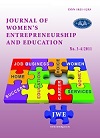Homogeneity of the European Union from the Point of View of Labour Marke
Main Article Content
Abstract
The paper deals with the idea of the European Union labour market homogeneity from the perspective of employment, unemployment, earnings and gender pay gap. Due to integration procedures within Europe, important mutual trade, capital and labour force mobility; it can be expected that labour market phenomena are gradually transmitted from western European countries to new member states. The paper proves a certain rate of labour market mimicking within Europe. Tendencies in unemployment, employment and earnings are at least partially transmitted to new member states as for female, male and total indicators. However, gender pay gap phenomenon is not transmitted in the same way. We can rather observe a certain clustering in gender pay gaps in European regions
Article Details
Section
Once the manuscript is accepted for publication, authors shall transfer the copyright to the publisher. If the submitted manuscript is not accepted for printing by the journal, the authors shall retain all their rights. The following rights on the manuscript are transferred to the publisher, including any supplementary materials and any parts, extracts or elements of the manuscript:
- the right to reproduce and distribute the manuscript in printed form, including print-on-demand;
- the right to print prepublications, reprints and special editions of the manuscript;
- the right to translate the manuscript into other languages;
- the right to reproduce the manuscript using photomechanical or similar means including, but not limited to photocopy, and the right to distribute these copies;
- the right to reproduce and distribute the manuscript electronically or optically using and all data carriers or storage media, and especially in machine readable/digitalized form on data carriers such as hard drive, CD-ROM, DVD, Blu-ray Disc (BD), Mini Disc, data tapes, and the right to reproduce and distribute the article via these data carriers;
- the right to store the manuscript in databases, including online databases, as well as the right to transmit the manuscript in all technical systems and modes;
- the right to make the manuscript available to the public or to closed user groups on individual demand, for use on monitors or other readers (including e-books), and in printable form for the user, either via the Internet, online service, or via internal or external networks.
Authors reserve the copyright to published articles and have the right to use the article in the same manner like third parties in accordance with the licence Attribution-Non-Commercial-Non-Derivate 4.0 International (CC BY NC ND). Thereby they must quote the basic bibliographic data of the source article published in the journal (authors, article title, journal title, volume, pagination).
